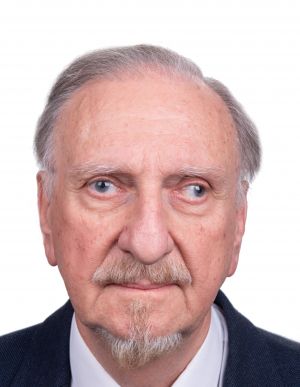ProfessorCzesław Rudowicz

A graduate of AMU - here he defended his master's thesis (1970) and doctoral thesis (1974). Since leaving the country in 1978, he worked first at universities in Nigeria (1978-80) - as the so-called Polservice’s specialist, and Germany (1980-82) - as a scholarship holder of the Humboldt Foundation. He obtained his habilitation through Adam Mickiewicz University in 1989, based on the achievements gained at the Australian National University (ANU), Canberra, Australia, where he worked in the years 1982-1989. He received the academic title of Professor of Physical Sciences in December 2002, also through AMU, on the basis of the achievements gained at the City University of Hong Kong (CityU), where he worked in 1989-2005, including from 1995 as Professor (Chair) in Physics.
Since returning to the Poland in 2005, he worked at the West Pomeranian University of Technology (ZUT) [until 2009 - Szczecin University of Technology] until September 2018. From August 2014, he lives again in Poznań. Since March 2015, he has been Visiting Professor at the Faculty of Chemistry, AMU.
He is the author or co-author of nearly 280 publications in the field of theoretical and experimental solid state physics and chemistry. The scientific achievements also include a number of extensive review articles, including in Magnetic Resonance Review (1987), Applied Spectroscopy Reviews (2001) and more recently Coordination Chemistry Reviews (2015). These works have received numerous citations, as evidenced by the Hirsch index 43.
- Founder President (since 1997; for life) & Immediate Past President (2004-08): Asia-Pacific EPR / ESR Society
- Advisory / Editorial Boards Membership: Appl. Mag. Reson.; Physica B; Indian J. Pure & amp; Appl. Physics
- Honorary Professorship: CityU, Hong Kong (2005/08); Hong Kong Institute of Education (2010)
- Fellow of the American Physical Society (Forum on International Physics), since Nov 2004.
- President, Polish EPR Society (April 2007 - May 2010); Chairman, Polish EMR Group (May 2010 - Sep 2022); Honorary Council Member, for life.
- Emeritus Professor, City University of Hong Kong (since June 2008)
Functions:
Awards:
Mentioned on the Stanford University List: Scientists among the top 2 percent of the world's most recognized scientists in 2022 and 2023.
Magnetism, optical and EMR (electron magnetic / paramagnetic / spin resonance: EPR/ESR) spectroscopy of transition (3d/4f) ions:
- ligand/crystal field theory,
- foundations of EMR,
- microscopic spin Hamiltonian theory,
- superposition model,
- low symmetry effects,
- nanomagnetism - molecular nanomagnets (MNM):
- single-molecule magnets (SMM),
- single-ion magnets (SIM)
Ten important Publications 2015-2023
- M. Karbowiak, J. Cichos, and C. Rudowicz, "Comment on the Crystal-field Analysis Underlying "Breakdown of Crystallographic Site Symmetry in Lanthanide-Doped NaYF4 Crystals", Angew. Chem. Int. Ed., 54, 1074-1076 (2015); DOI: 10.1002/anie.201408640
- C. Rudowicz and M. Karbowiak, “Disentangling intricate web of interrelated notions at the interface between the physical crystal field Hamiltonians and the effective spin Hamiltonians”, Coordination Chemistry Reviews, 287, 28-63 (2015); DOI: 10.1016/j.ccr.2014.12.006.
- M. Karbowiak, C. Rudowicz, and J. Cichos, "Extension of High-Resolution Optical Absorption Spectroscopy to Divalent Neodymium: Novel Absorption Spectra of Nd2+ Ions in Strontium Chloride Host SrCl2", Angew. Chem. Int. Ed., 56, 10721-10724 (2017); DOI: 10.1002/anie.201704559; .
- A. Gorczyński, D. Marcinkowski, M. Kubicki, M. Löffler, M. Korabik, M. Karbowiak, P. Wiśniewski, V. Patroniak, and C. Rudowicz, "New field induced single ion magnets based on prolate Er(III) and Yb(III) ions: tuning the energy barrier Ueff by the choice of counterions within N3-tridentate Schiff-base scaffold", Inorganic Chemistry Frontiers, 5, 605-618 (2018). DOI: 10.1039/c7qi00727b).
- M. Kozanecki, C. Rudowicz, H. Ohta, T. Sakurai, "High-frequency EMR data for Fe2+ (S = 2) ions in natural and synthetic forsterite revisited - fictitious spin S' = 1 versus effective spin S~ = 2 approach", J. Alloys and Compounds, 726, 1226-1235 (2017). DOI: 10.1016/j.jallcom.2017.07.227).
- C. Rudowicz, P. Gnutek, M. Açıkgöz, “Superposition Model in Electron Magnetic Resonance Spectroscopy - a Primer for Experimentalists with Illustrative Applications and Literature Database", Applied Spectroscopy Reviews, 54/8, 673-718 (2019); DOI: 10.1080/05704928. 2018.1494601.
- C. Rudowicz, K. Tadyszak, and T. Ślusarski, "Can the correspondence principle lead to improper relations between the uniaxial magnetic anisotropy constant K and the axial zero-field splitting parameter D for adatoms on surfaces?", J. Mag. Mag. Mat., 471, 89-96 (2019). DOI: 10.1016/j.jmmm.2018.09.050.
- A. Biswas, S. Sarkar, Y.M. Jana, S. Nandi, D. Swarnakar, C. Rudowicz, M. Açıkgöz and N.M. Avram, “Analysis of crystal-field effect on luminescence spectra of Mn4+ (3d3) ion doped double perovskite La2ZnTiO6 phosphor by semiempirical computations: exchange charge model and superposition model”, submitted 27.01.2022, J. Mater. Chem. C, 10, 4355-4364 (2022). DOI: 10.1039/D2TC00407K.
- D. Marcinkowski, A. Adamski, M. Kubicki, G. Consiglio, V. Patroniak, T. Ślusarski, M. Açıkgöz, D. Szeliga, N. Vadra, M. Karbowiak, I. Stefaniuk, C. Rudowicz, A. Gorczyński, M. Korabik, “Understanding the effect of structural changes on slow magnetic relaxation in mononuclear octahedral copper(II) complexes”, submitted 19.05.2022; Dalton Transactions, 51, 12041-12055 (2022). DOI: 10.1039/d2dt01564a.
- R. Ghosh, S. Sarkar, Y.M. Jana, D. Piwowarska, P. Gnutek, C. Rudowicz, Eu3+ ions as crystal-field probe for low-symmetry sites in doped phosphors - case study: Eu3+ at triclinic sites in Li6RE(BO3)3; RE = Y, Gd, and YBO3, ZnO, and at trigonal sites in YAl3(BO3)4, Physical Chemistry Chemical Physics, 25, 25537–25551, 2023; DOI: 10.1039/d3cp03090c.